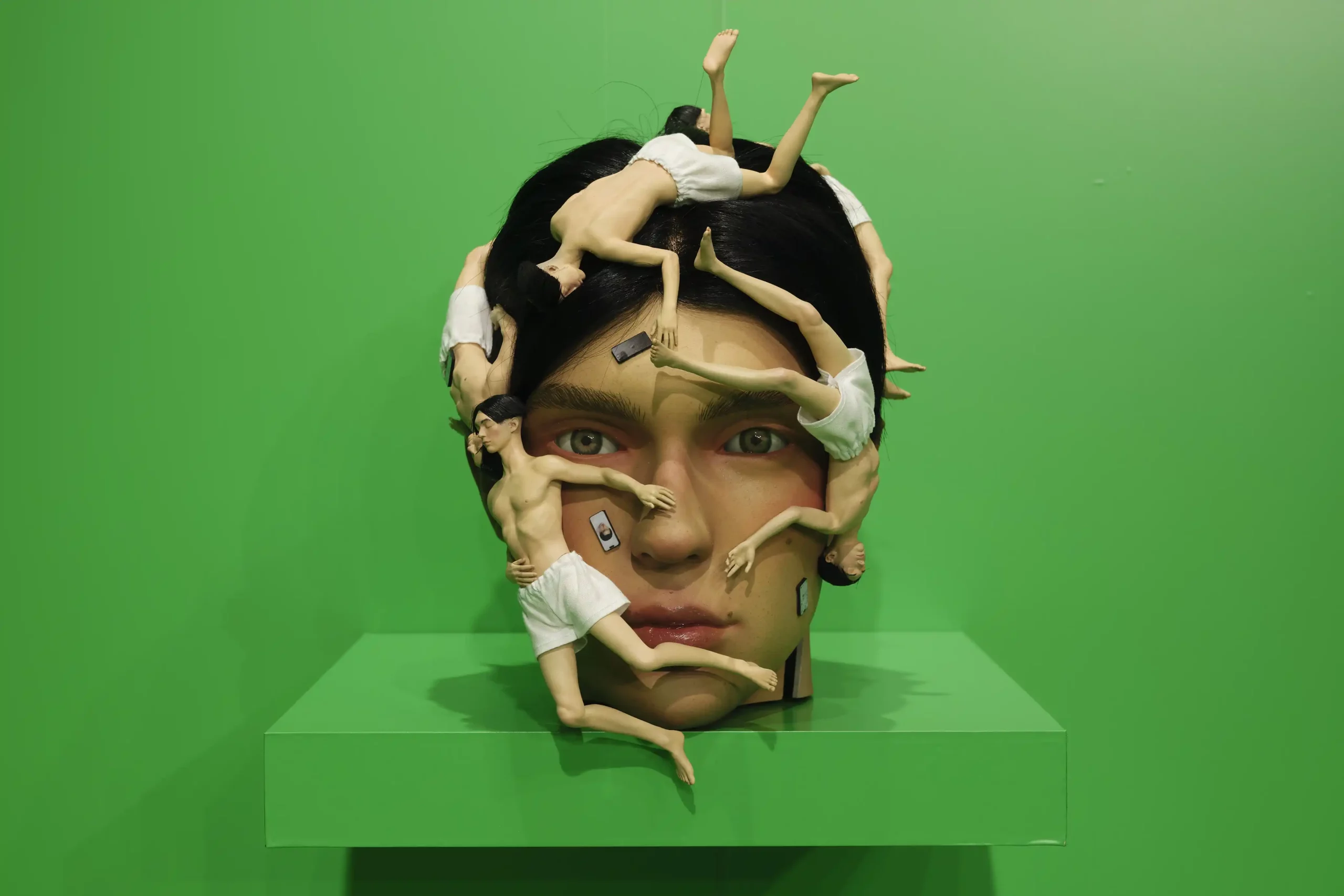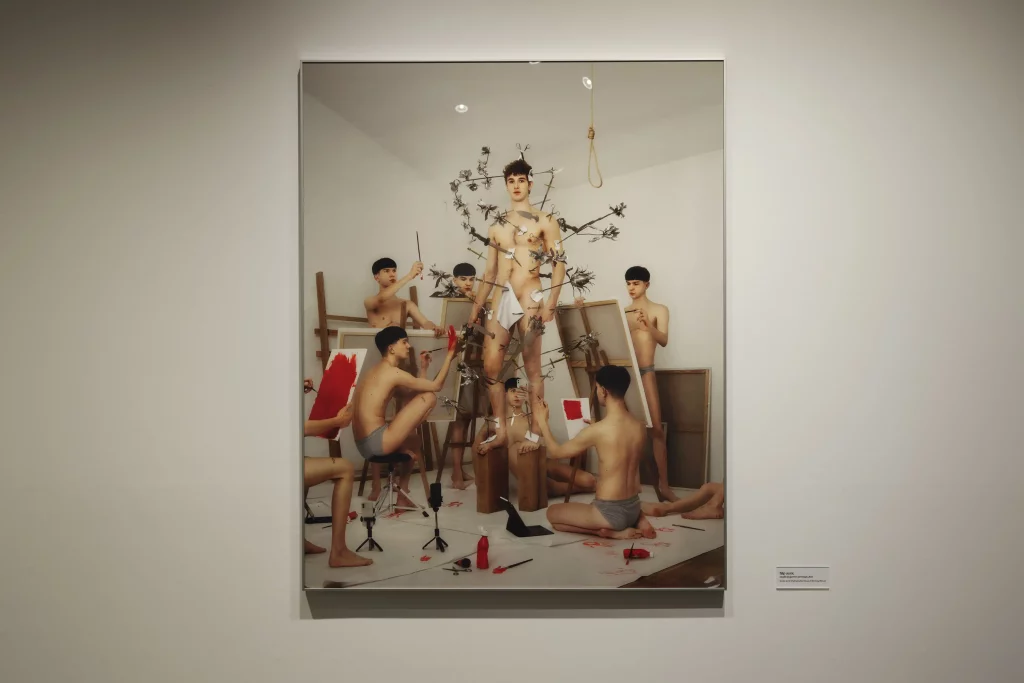As a former marketing student, Filip Custic questions the risks of capitalist culture, which argues that existence is more valuable if it can be monetized
‘Human product’ by Filip Custic
Body, mind and technology: these three elements interact with each other more and more frequently to shape our identity, to define the ‘Human product’. In his first solo show in Tokyo, Filip Custic shares his interest in and critical thinking about our contemporary world: consumerist and capitalist.
Immediate present, short-term future for Filip Custic
The exhibition is a collaboration between Colección SOLO, an international artistic support project based in Spain, and PARCO Museum, in Tokyo. Filip Custic explains how this exhibition was designed: «To me the relationship with technology is very obvious. At a certain point I realized that I had to look at my past and learn everything that humans have learned from the past.
For quite some time now, my work has been very much inspired by the immediate present and the short-term future. While researching, I realized that the only differentiating factor between our era and that of a hundred years ago is technology, the internet, and that the new thing I could bring to my time is to exploit the technological concept.
All this relates to identity, who we are, the structures we create to define ourselves and how technology crosses us. I think we will suddenly look super bionic in the future, full of technology, and we will say, ‘When did all this happen?’ But I think it is going to be a very organic process, step by step and little by little. I observe this evolution, seeing that I am part of it and I portray it artistically because as an artist I seek to document and portray my present or my near future».
Japan as a leader in technological innovation
Since the 1980s, Japan has been at the vanguard of technology: in 1988, the country had fifty percent of the world’s semiconductor production and was the first to connect mobile phones to the Internet. Innovation has played a crucial role in the vitalisation of the Japanese economy, and still today the Country’s technology research is shaping the future from surgical robots to cutting-edge recycling technology.
«Coming to Tokyo was already a dream for me. But coming to Tokyo to exhibit and communicate my creativity is really amazing. In my creative processes I am inspired by the most classic ideas of Asian culture, such as feng shui, but also anime and manga have influenced my creativity a lot. I like to combine Western culture with Eastern elements. And I think that combination is very fresh».
Filip Custic’s multidisciplinary approach
Filip Custic investigates human existence and its ability to update, almost like an operating system: «my approach is to document my life, from my personal point of view focusing on a few details that I like to emphasize. Talking about media, I like to materialize through all possible media, depending on the idea could be a sculpture, a video, or picture. And as I learn new skills, I’m able to use new media or formats to express my ideas».
The exhibition expresses the multidisciplinary essence of the artist’s artistic practice through a variety of different artworks, from prints to wearables, installation and performance, some of them commissioned especially for the occasion.
Identities and bodies influenced and shaped by technology: Filip Custic
Through all these techniques, Filip Custic documents and questions the self-imposed social models looking at the way identities and bodies are influenced and shaped by technology: «I used to express myself exclusively photographically, but a couple of years ago I began to diversify the media through which I communicated the idea. I started to play with sculpture, to materialize also in video, or to play with more virtual ideas such as filters, etc.
Then there was a moment when I felt I had no more past to look at. Then I was in the present and already looking towards the future and I saw that the only differentiating element of our present was technology. At that moment I felt that technology is the only innovative element of our era and that for me it is an infinite medium, with a surprise factor».
The empowerment and objectification of human bodies
The artist’s work reveals an interest not only in the body, but also in psychology and sociology, portraying the empowerment and objectification of human bodies: «I am interested in understanding our era, the time we are living now and, as an artist, to generate a portrait of it. I have studied the past and my way of investigating the moment we live and the topics I am interested in, has many sources. I read, I observe, I study and I do it from different sources, from a book to an Instagram account».
While the technological boom is changing also the art world, and image generators are spreading on social media forcing questions about online misinformation, Filip Custic is confident about the role of creativity: «From my point of view, creativity is in a transition moment because new emergencies are emerging, for example in photography, which we have not yet discovered its full potential. For all these reasons I believe that we will soon reach a new stage in the field of creation».
Filip Custic on capitalism and imagination
With his work, Filip Custic invites to open debate about the impact of technology on the human body and identity and, as a former marketing student, to question capitalist culture risks: «In the exhibition, capitalism and how it affects us fired my imagination. I wanted to generate a dialogue, a conversation, about what our existence is like and how we are capable of inventing systems that mark our lives, such as the economic system.
I would like to open a conversation focused on how consumerist culture attempts to turn us into ‘commodities’ while proposing that our existence is more valid if it can be monetised. I want to go deeper and reflect on human existence and our ability to update ourselves almost like an operating system (OS) while examining our tendency to create complex systems that give meaning to our lives».
Is it digital or the real world?
Digital technologies have advanced more rapidly than any other innovation in human history and it seems difficult to stop the transformation they are making by turning the digital world into a real one and the real world into a digital one. Filip Custic says: «I think they are slowly becoming one world. The digital world and the real world have been somewhat disconnected, but now I think with tools such as AR everything is going to be more integrated».
Masks play an important role in custic’s practice as a way to distort one’s image and as a way to bring himself closer to a , a virtual avatar: «I want to continue developing my 3D printing sculptures I’m showing in Tokyo at PARCO Museum because this is the first time that I’m showing this kind of format. In my artistic career, I like to continue exhibitions all around the world, expressing and showing my learnings and learning about myself».
Filip Custic
Filip Custic (Santa Cruz de Tenerife, Spain 1993) works across photography, performance and video to address themes around identity, body and our relationship with technology. Mirrors and screens are recurring features, a reference to our age of ima- ge-obsession and selfies, and Custic also uses symbols, references to science, and art-historical borrowings in his art.
The artist focuses his work on the crossover be- tween technology and the body, talking about identity and how technological objects can help us celebrate the diversity of identities of human beings. Custic is the artist behind the album visuals for Rosalía’s El Mal Querer and Lil Nas’s US No 1 hit, MONTERO (Call me by your name).




















